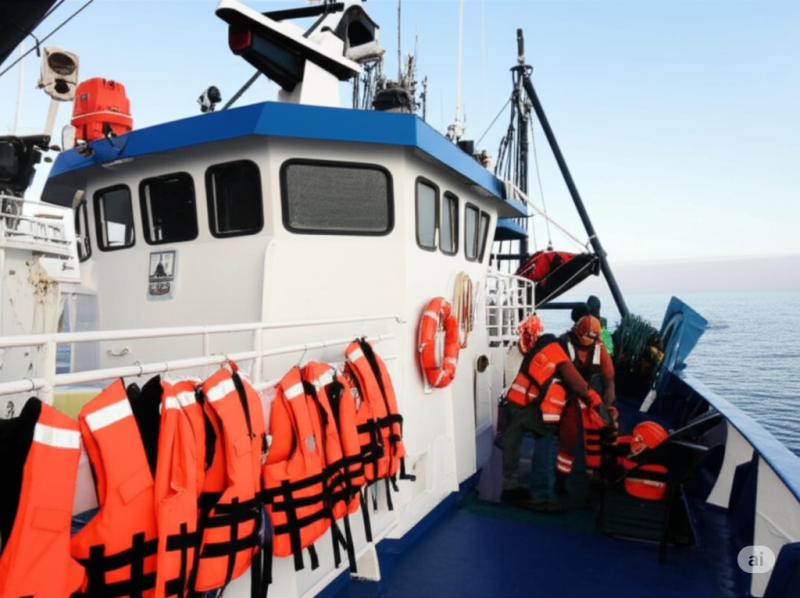
Modern fishing vessels navigate challenging, and often unpredictable, marine environments. To safeguard the crew and ensure the security of fishing operations, these vessels are mandated by national and international regulations to carry a comprehensive suite of safety equipment. This gear is critical for preventing accidents, responding to emergencies, and ultimately, saving lives at sea.
Generally, safety equipment on modern fishing vessels can be categorized as follows:
1. Life Saving Appliances (LSA)
These are crucial for crew survival in dire situations:
- Life Jackets: A mandatory item for every crew member. Designed to keep an individual afloat in an emergency, they are typically bright orange and equipped with a whistle and reflective tape for enhanced visibility.
- Lifebuoys/Ring Buoys: Ring-shaped devices thrown to a person in the water. They are equipped with a grab line and often feature a self-igniting light for nighttime use and a smoke signal for daytime visibility.
- Inflatable Liferafts: Automatically inflating rafts launched overboard in an emergency. They are designed to accommodate a specific number of people and are usually stocked with survival supplies such as drinking water, food rations, first-aid kits, and visual signaling devices.
- Rescue Boats/Lifeboats: Larger fishing vessels may be equipped with more robust, motorized or oar-propelled rescue boats.
- Visual Distress Signals:
- Smoke Signals: Used during daylight hours to attract the attention of rescue teams by emitting brightly colored smoke.
- Hand Flares: Produce a brilliant red light, effective for attracting attention at night or in low-light conditions.
- Parachute Flares: Launch a flare high into the air, which then descends slowly under a parachute, emitting a bright red light visible from a great distance.
- Line Throwing Apparatus: Used to project a rescue line to a person overboard or to another vessel.
- Immersion Suits: Specialized suits designed to protect the wearer from hypothermia when immersed in cold water for extended periods.
2. Fire Fighting Equipment
Fire at sea is a significant hazard, and vessels are equipped accordingly:
- Portable Fire Extinguishers (APAR): Various types (CO2, foam, dry powder) are strategically placed throughout the vessel to tackle different classes of fire.
- Fixed Fire Fighting Systems: Engine rooms and other high-risk areas on modern vessels may be equipped with automatic fire suppression systems, such as CO2 flooding or water mist systems.
- Fire Hoses and Nozzles: Connected to seawater pumps to deliver water for firefighting.
- Fireman’s Outfit: Includes a fire-resistant suit, helmet, gloves, boots, and Self-Contained Breathing Apparatus (SCBA) for onboard firefighting duties.
3. Emergency Navigation and Communication Equipment
Maintaining contact and position awareness is vital:
- Emergency Position Indicating Radio Beacon (EPIRB): An emergency transmitter that, if the vessel sinks, automatically sends a distress signal with the vessel’s position via satellite to rescue coordination centers.
- Search and Rescue Transponder (SART): A device that responds to radar signals from rescue ships or aircraft, helping to pinpoint the location of survivors or a liferaft.
- VHF Radio with Digital Selective Calling (DSC): Allows for automatic distress calls containing vessel information and position.
- GPS (Global Positioning System): Essential for determining the vessel’s precise location.
- Radar: Used to detect other vessels, landmasses, and adverse weather conditions.
- Compasses (Magnetic and Gyro): For determining the vessel’s heading.
- Echo Sounder/Depth Sounder: Measures the depth of the water beneath the vessel’s keel.
- AIS (Automatic Identification System): Automatically transmits and receives vessel information (name, position, speed, course) to other ships and coastal stations.
- Navigation Lights: Standardized colored lights with specific placements to indicate a vessel’s position, status, and direction of travel at night or in restricted visibility.
- Vessel Monitoring System (VMS): A satellite-based system that tracks the vessel’s location in real-time, crucial for safety and fisheries management.
4. Personal Protective Equipment (PPE) for Crew
Day-to-day safety relies on appropriate PPE:
- Safety Helmets: Protect the head from impacts or falling objects.
- Safety Shoes/Boots: Protect feet from injury, often waterproof and anti-slip.
- Protective Gloves: Shield hands from cuts, chemicals, or extreme temperatures.
- Safety Goggles/Face Shields: Protect eyes and face from splashes or flying particles.
- Workwear/Coveralls: Appropriate clothing for working conditions at sea, sometimes waterproof or high-visibility.
- Ear Protection (Ear Plugs/Ear Muffs): Used in high-noise areas like the engine room.
5. Other Safety Equipment
A range of additional tools enhance onboard safety:
- First Aid Kit: Contains medical supplies and basic equipment for treating injuries.
- Emergency Anchor: To hold the vessel’s position in an emergency.
- Emergency Bilge Pump: To remove water that has entered the vessel.
- General Alarm: To alert the crew to an emergency situation.
- Embarkation/Pilot Ladder: For safely boarding and disembarking the vessel.
- Oil Spill Response Equipment: Especially for larger vessels, to manage and contain oil spills.
Crucial Considerations:
It’s important to note that the specific list and specifications of safety equipment can vary depending on the vessel’s size, area of operation, type of fishing gear used, and the regulations of the flag state and the waters where the vessel operates.
Beyond the mere presence of this equipment, regular training and drills on the use of these safety devices are paramount. A well-equipped vessel is only truly safe when its crew is well-prepared, knowledgeable, and proficient in emergency procedures. Ensuring that all crew members understand how and when to use each piece of safety equipment is a fundamental aspect of maintaining a safe working environment on any modern fishing vessel.

